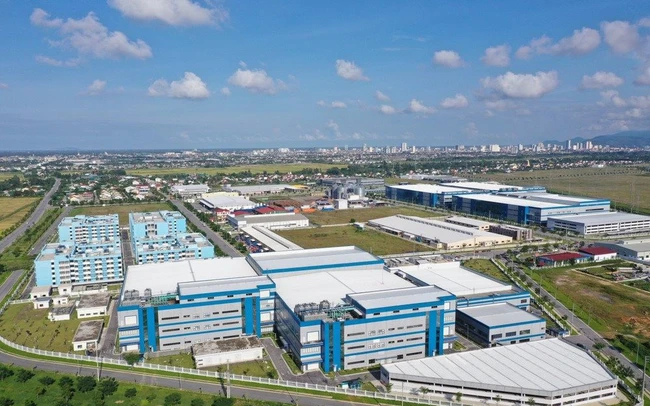NEW GLOBAL MANUFACTURING HUB
Vietnam is rapidly emerging as a new global manufacturing hub as per “China plus one” or switch-from-China strategy adopted by many leading multinationals.
Overview
In light of the continued US-China trade disputes (and previously China’s unresponsive Covid-19 policies), manufacturing businesses are looking for the next best option to set up their factories or move their current China-based manufacturing facilities. Vietnam has emerged as one of the best options, besides India. Vietnam is popular for being a manufacturing center, particularly for higher-income countries pursuing the “China plus one” approach. This approach is a business strategy in which corporations diversify or switch their investments outside of China to lessen their dependency.

Vietnam – numerous advantages & strengths
Vietnam has been playing an increasingly significant role in global supply chains, as the nation has huge advantages in the era of alleged de-globalization. Since 2000, Vietnam’s GDP has grown at a faster rate than in any other Asian country bar China, averaging 6.2% annually (for the entire 20-year period).
Vietnam possesses numerous advantages in terms of geography (central location in Asia, proximate to China, long coastline of 3,260 km), demography (abundant labor force of 52 mil people, relatively young, well-educated, and skillful), massive infrastructure development (new highways, deep sea ports, industrial parks, electronics clusters), and reasonable cost base (minimal capex and overheads such as land, buildings, and labor compared to peer countries).
On the macro level, Vietnam has appropriate policies to encourage FDI and puts more emphasis on creating a liberal, impartial environment. It also fosters the assistance of supporting industries and deeper interaction with existing and future investors by creating the essential circumstances for efficient decentralization of FDI administration.
Only a handful of economies like Vietnam have a combination of all above factors to provide such ground for shifting manufacturing destinations in Asia.
Nikkei Asia said Vietnam has earned its status as a global production hub, adding that it is already the only economy of its size and growth level to have cracked the top six in Apple’s coveted supplier list. Vietnam has emerged as an important link in the global supply chain when it has recorded technology merchandise export growth that no substantial Asian rival has matched. In specifics, high-tech goods as a share of exports hit 19.4% in 2022, up from 13% in 2010. The total export turnover of computers, phones and electronic devices reached US$71.93bn in 2022, up 25% from the previous year.
Compal Vietnam (Taiwanese-invested), based in Vinh Phuc province with a US$500mn laptop factory, with 15,000 workers, is a manufacturer for Dell, Google and Amazon. Compal was striving to increase its export turnover to 1.5-2 billion USD per year.
With Compal’s supplies for Dell, Google and Amazon for export, it can be seen that Vietnam is really becoming a manufacturing center of the world, at least in the field of electronics. Along with big manufacturers that have their own factories such as Samsung, Intel and LG, there are more and more manufacturers specializing in outsourcing for world-famous electronic brands in Vietnam. Foxconn, Luxshare, Winston, Pegatron and Goertek are typical examples. The presence of the big names has made Vietnam a base for the production of electronics and mobile phone components, which are mostly targeted for export.
Despite continued global turbulences (i.e. the US-China trade war, the Russia-Ukrain war and Russia-Western conflicts and the Covid-19), Vietnam’s FDI attraction has not shown much of decline (US$27.7 bn in 2022), which demonstrated consistent confidence from investors, including Foxconn, Pegatron, Wistron, LEGO and Nike, in the country’s economic prospects.
India versus Vietnam in key parameters
One of the fastest-growing economies, India, had been another promising candidate. However, according to Bloomberg, since 2014, the country has recorded one of the worst worker participation rates anywhere in the world. On top of that, the Indian government has signed no FTAs in its tenure of eight years and has yet to give much attention to improving its industrial policy.
India is squandering a US$28 trillion potential in global commerce by adopting a more nationalistic approach. This inward tendency stems from the notion that a 1.4 billion-people economy can be sustained only by internal demand. Even before Covid-19, only around 1% to 2% of India’s population could be classified as middle class, compared to 25% in China. Several well-known economists believe that the overall objective of a “self-reliant economy” is relatively tough to attain for India.
On the contrary, Vietnam is adopting the East Asian Tiger countries’ success formula: open and frictionless trade. The country is gaining a greater market share in international commerce than India, despite a fraction of the population (about 1/14 or 7%).
Final remarks
Vietnam’s manufacturing landscape offers many opportunities for businesses seeking cost-effective production, abundant skilled labor, and a favorable business environment. The major manufacturing industries, strategic hubs, and favorable cost comparisons with China make Vietnam an attractive destination for manufacturing investment. Chinese investment in Vietnam’s manufacturing sector further strengthens its growth trajectory. Understanding the driving forces behind the shift to Vietnam, including advantages in cost, trade agreements, political stability, and skilled labor availability, is crucial for businesses considering manufacturing relocation or expansion.
Moreover, Vietnam’s skilled labor force, infrastructure development, efficient supply chain management, and favorable tax incentives create a conducive environment for manufacturing success. Navigating the regulatory landscape and understanding the future prospects of Vietnam’s manufacturing industry are key considerations for businesses looking to establish or expand their operations.
As Vietnam continues to evolve as a manufacturing hub, embracing technological advancements and focusing on sustainability will be essential for long-term growth. By staying informed about emerging trends, challenges, and opportunities, businesses can position themselves for success in Vietnam’s dynamic manufacturing landscape.
Gửi Yêu cầu Dịch vụ
B17-16, Sunrise City View, 33 Nguyễn Hữu Thọ., Quận 7, Tp. Hồ Chí Minh, Viêt Nam
Tầng 2 Helios Tháp A, 75 Tam Trinh., Q. Hoàng Mai, Hà Nội, Việt Nam
+84 775 121 131